Journal Information
Editor-in-chief : Assoc. Prof. Dr. Akkarapon Nuemaihom



Manuscript Preparation Guidelines for Manuscript Submission BRU ELT JOURNAL
Ph.D. Program in English Language Teaching (ELT)
Faculty of Humanities and Social Sciences
Buriram Rajabhat University
---------------**---------------
The full manuscript must be submitted in the MS word DOC format as an electronic file by using Microsoft Office Word 2010 onwards via the https://so14.tci-thaijo.org/index.php/bru_elt_journal. It must be strictly cited in line with APA, 7th edition. The following are some manuscript preparation guidelines:
1. The manuscript must be typed on A4 paper, including figures, tables, references, and author’s brief personal data. Moreover, it should be between 4,000 and 8,000 words (including references and appendices).
2. Font
2.1 Times New Roman with font size 12 is required. The article must be typed in one column and single spacing.
2.2 The paper title should be in bold at a font size of 14 points with initial caps and be centered.
2.3 The author's name (and the advisor’s name) must be typed in bold using font size 12 and centered on the page.
2.4 Department(s)/program(s), faculty(s), affiliation(s), and e-mail address must be set flush on the left using font size 10 below the author’s name.
3. The components of academic articles are as follows:
3.1 Title: The title should possess short, concise, and meaningful words. It should be written at a word level, not a sentence level. The title with 8-15 words must be written
3.2 Abstract: The article contents are clearly summarized. A one-page abstract with 150-200 words is required.
3.3 Keyword: The keywords appropriate for retrieving information from the database are identified. About 3-5 keywords are required and must be placed below the abstract.
3.4 Introduction: The article’s background is presented. The article’s scope is also specified.
3.5 Body of Text: The main contents and sub-topics of the article are identified. Moreover, the topics are sorted by content.
3.6 Conclusion: The conclusion of an article is the segment where you encapsulate and finalize your study without merely restating the introduction or results section. The conclusion of the article should not present new information or data that was not addressed in the main body of the work. Your study should be concluded with a thought-provoking or memorable statement. This might create a profound impact on your readers and conclude your article effectively.
3.7. References: In-text citation is based on the author-year system of the APA (American Psychological Association) style, 7th edition. It is noted that all entries in the text should be listed in the references.
It is noted that for writing an academic article, clear points should be identified and appropriate sequences of content should be considered.
4. The components of research articles are as follows:
4.1 Title: The title should possess short, concise, and meaningful words. It should be written at a word level, not a sentence level. An 8-15 word title is required.
4.2 Abstract: The first section of your abstract is very valuable real estate, so these 1-3 sentences must inform the reader about why you have undertaken this research, and what context or background information is for your research. Then you should state the aim or purpose of your work. After that, the research methodology should be briefly described. Finally, you must describe the most important findings of your study. The length is not more than 1 page or between 150-200 words.
4.3 Keyword: The keywords appropriate for retrieving information from the database are identified. The 3-5 keywords are required and must be placed below the abstract. Moreover, small letters are required except for a technical term.
4.4 Introduction: The significance of research problems is identified. The relevant literature is reviewed. In addition, the overall benefits obtained from the research results are also presented.
4.5 Objective: The research objectives are identified to reflect the overall picture of the research.
4.6 Methodology: The research methods, including population, samples, instruments, steps of data collection, and statistics for data analysis, are clearly indicated.
4.7 Results: The research results obtained from analyzing the data are clearly interpreted according to the research objectives.
4.8 Discussion: The research results are discussed with theoretical support so as to check whether the current research results are in line with or against the previous studies.
4.9. Conclusion: The conclusion of your research article is the segment where you encapsulate and finalize your study, articulating the principal findings and insights obtained from your study without merely restating the introduction or results section. The conclusion of the article should not present new information or data that was not addressed in the main body of the work. Your study should be concluded with a thought-provoking or memorable statement. This might create a profound impact on your readers and conclude your research article effectively.
4.10 Recommendations: Utilization of the research results, and guidelines for the next research should be recommended.
4.11 References: The references must be based on APA (American Psychological Association) style, 7th edition.
5. Page Set up
5.1 Headings: All headings should be in bold letter. Headings and subheadings should be set flush left at the font size of 14 with initial caps. A blank line should be used to separate paragraphs when each section is finished. The sequential numbers are not required.
5.2 Margin: The top and left margins must be set at 3.81 centimeters and those for bottom and right must be at 2.54 centimeters. It is noted that a page number is prohibited. Moreover, each paragraph should be indented at 1.90 centimeters from the margin.
5.3 Tables: Tables are numerical values or text displayed in rows and columns. The tables must be numbered accordingly, and a particular number must be typed in the same line. The table title appears one double-spaced line below the table number. To correctly format an APA table, follow these rules:
-Table number in bold above the table.
-Brief title, in italics and title case, below the table number.
-No vertical lines.
-Horizontal lines only where necessary for clarity.
-Clear, concise labels for column and row headings.
-Numbers consistently formatted (e.g. with the same number of decimal places).
-Any relevant notes below the table.
Look at the example below: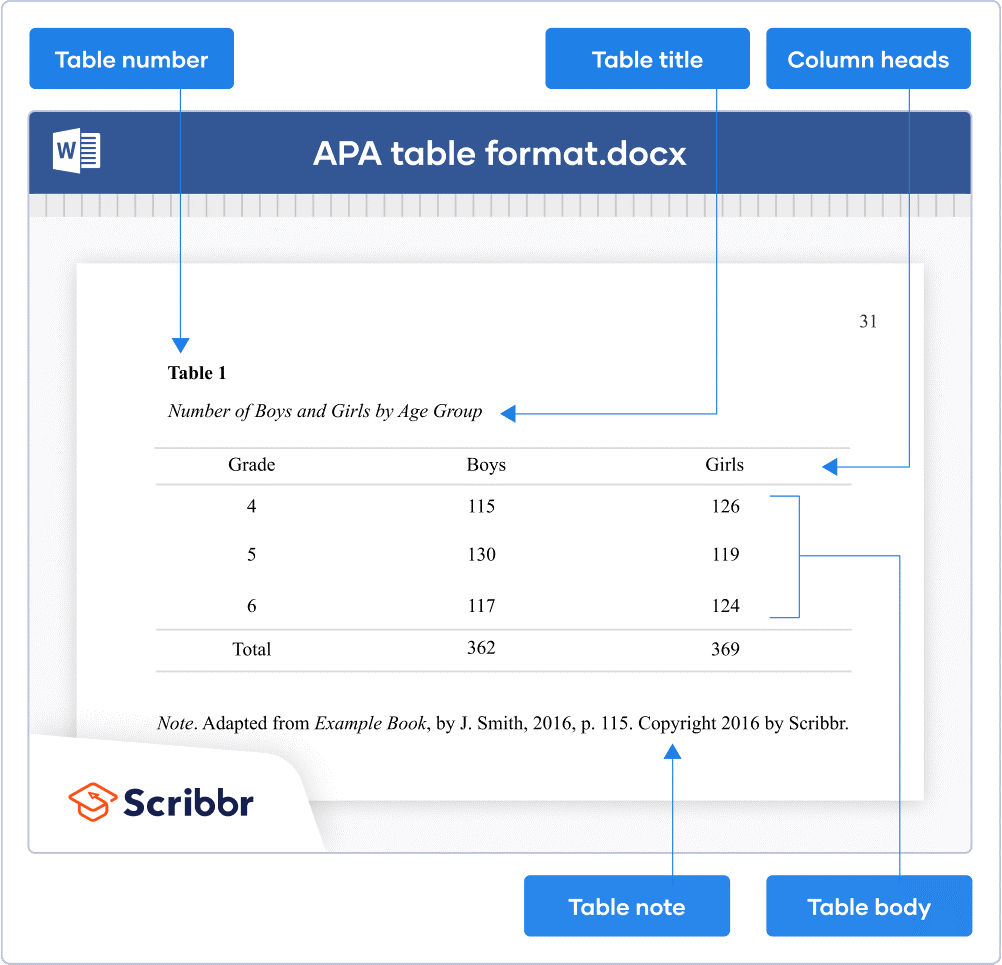
Note. Generate accurate APA citations for free. From APA Format for Tables and Figures | Annotated Examples, by J. Caulfield,2022, (https://www.scribbr.com/apa-style/tables-and-figures/). Copyright 2022 by Scribbr.
5.4 Figure: Figures include graphs, charts, maps, drawings and photographs. The figure title appears one double-spaced line below the figure number.
To correctly format an APA figure, follow these rules:
-Figure number in bold above the figure.
-Brief title, in italics and title case, under the figure number.
-If necessary, clear labels and legends are integrated into the image.
-Any relevant notes below the figure.
Look at the example below: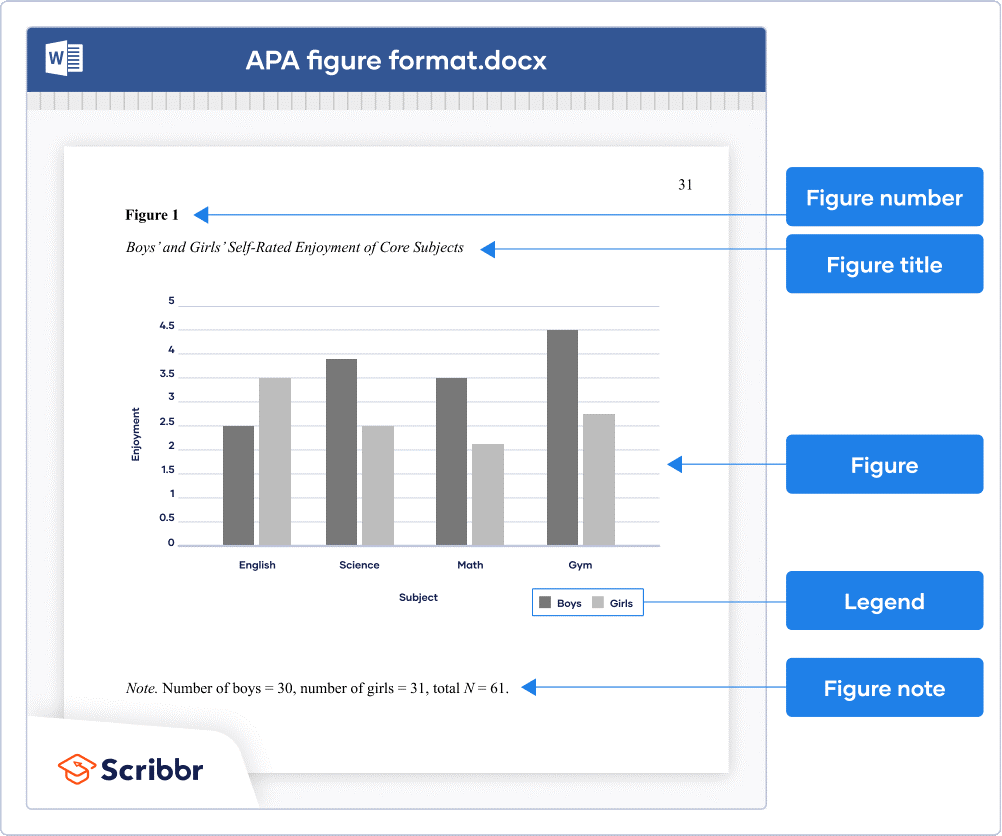
Note. Generate accurate APA citations for free. From APA Format for Tables and Figures | Annotated Examples, by J. Caulfield,2022, (https://www.scribbr.com/apa-style/tables-and-figures/). Copyright 2022 by Scribbr.
5.5 Equations: All equations should be placed on separate lines. A blank line should be left before and after equations. Look at the example below:
Ti = f(x)
6. In-text citation
APA, 7th edition, is an 'author/date' system, so your in-text references for all formats (book, journal article, web document) consists of the author(s) surname and year of publication. The basics of an in-text reference in APA (Victoria University, 2022):
6.1 Include author or authors and year of publication, and use round brackets.
Example: (Smith & Bruce, 2018)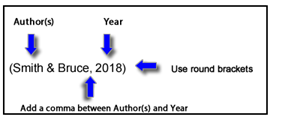
6.2 Include author or authors, year of publication and page or paragraph number of your quote, and use round brackets.
Example: (Smith & Bruce, 2018, pp. 25-26)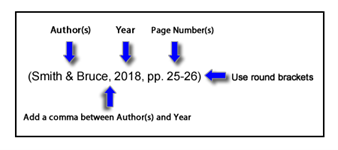
6.3 When citing multiple works in the same parentheses, citations are presented in alphabetical order, separated with semicolons.
E.g.
While other positive psychology constructs (e.g., resilience, hope, core self-evaluations, social support) have been studied in people with MS (Alschuler et al., 2018; Arewasikporn et al., 2018; Farber et al., 2015; Lee et al., 2020; Lynch et al., 2001; Madan & Pakenham, 2014), there is a dearth of research examining grit in this population.
7. References
7.1 References are listed fully in alphabetical order (A-Z) according to the last name of an author and are not numbered.
7.2 The last name is written first, followed by the initial letter of his/her first name. Moreover, the first line of each entry must be printed and left aligned. If there are more lines for each entry, the other lines should be indented for seven letters.
7.3 If it is not completed in the first line, the next line is indented for seven characters, and typed in the 8th character.
7.4 For the works that are part of a greater whole (e.g., journal articles, edited book chapters), do not italicize the title or use quotation marks, and capitalize it using sentence case. For example:
The virtue gap in humor: Exploring benevolent and corrective humor
For the works that stand alone (e.g., books, reports, webpages, and websites), italicize the title, and capitalize it using sentence case. For example:
Adopting-specific therapy: A guide to helping adopted children and their families thrive
Use title case if the titles of articles, books, reports, and other works appear in the text. For example:
…in the book Bilingualism Across the Lifespan: Factors Moderating Language Proficiency
…in the article “Media Influences on Self-Stigma of Seeking Psychological Services: The Importance of Media Portrayals and Person Perception”
It is noted that APA Style uses two types of capitalization for the titles of works and headings within works: title case and sentence case. In title case, major words are capitalized. In sentence case, most words are lowercased. Nouns, verbs, adjective, adverbs, pronouns, and all words of four letters or more are considered major words. Short (i.e., three letters or fewer) conjunctions, short prepositions, and all articles are considered minor words.
7.5 When compiling your APA Reference List, you should (Victoria University, 2022):
-List references on a new page with a centred heading titled: References.
-Include all your references, regardless of format, e.g. books, journal articles, online sources, in one alphabetical listing from A - Z.
-Order entries alphabetically by surname of author(s).
-List works with no author under the first significant word of the title.
-Indent second and subsequent lines of each entry (5-7 spaces).
-Use double spacing.
-Note that all references in APA end with a full stop except when the reference ends with a URL or a DOI.
7.6 Journal article
A basic reference list entry for a journal article in APA must include:
-Author or authors. The surname is followed by first initials
-Year of publication of the article (in round brackets)
-Article title
-Journal title (in italics)
-Volume of journal (in italics)
-Issue of journal (no italics)
-Page range of article
-DOI (presented as a hyperlink, for example https://doi.org/xxxxx).
The first line of each citation is left adjusted. Every subsequent line is indented 5-7 spaces
For example:
Ruxton, C. (2016). Tea: Hydration and other health benefits. Primary Health Care, 26(8), 34-42. https://doi.org/10.7748/phc.2016.e1162
7.7 Book
A basic reference list entry for a book from a library database in APA must include:
-Author or authors. The surname is followed by first initials
-Year of publication of the book (in round brackets)
-Book title (in italics)
-Edition (in round brackets), if other than first edition
-Publisher
-DOI (where a book has a DOI this must be included, even if you are referring to a print book)
-The first line of each citation is left adjusted. Every subsequent line is indented 5-7 spaces
For example:
Arnott, G. D. (2017). The disability support worker (2nd ed.). Cengage Learning.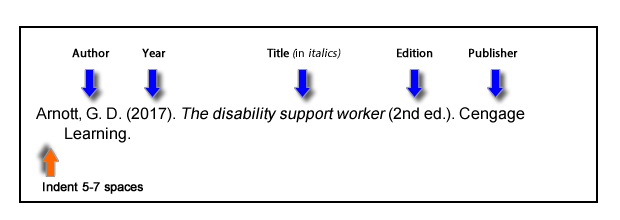
For more information about the American Psychological Association (APA) style citation system, 7th edition, you can discover it at: www.apa.org.
7.8 Reference List: Author/Authors (Purdue University, 2022)
7.8.1 One author
Last name first, followed by author initials.
Ahmed, S. (2012). On being included: Racism and diversity in institutional life. Duke University Press.
7.8.2 Two authors
List by their last names and initials. Separate author names with a comma. Use the ampersand instead of "and."

7.8.3 Three to twenty authors
List by last names and initials; commas separate author names, while the last author name is preceded again by ampersand.
7.8.4 More than twenty authors
List by last names and initials; commas separate author names. After the first 19 authors’ names, use an ellipsis in place of the remaining author names. Then, end with the final author's name (do not place an ampersand before it). There should be no more than twenty names in the citation in total.
7.8.5 Group author
Group authors can include corporations, government agencies, organizations, etc.; and a group may publish in coordination with individuals. Here, you simply treat the publishing organization the same way you'd treat the author's name and format the rest of the citation as normal.
7.8.6 Two or more works by the same author
Use the author's name for all entries and list the entries by the year (earliest comes first). List references with no dates before references with dates.
Urcuioli, P. J. (n.d.).
Urcuioli, P. J. (2011).
Urcuioli, P. J. (2015).
When an author appears both as a sole author and, in another citation, as the first author of a group, list the one-author entries first.
References that have the same first author and different second and/or third authors are arranged alphabetically by the last name of the second author, or the last name of the third if the first and second authors are the same.

7.8.7 Two or more works by the same author in the same year
If you are using more than one reference by the same author—or the same group of authors listed in the same order—published in the same year, first check to see if they have more specific dates. Works with only a year should be listed before those with a more specific date. List specific dates chronologically. If two works have the same publication date, organize them in the reference list alphabetically by the title of the article or chapter. If references with the same date are identified as parts of a series (e.g. Part 1 and Part 2), list them in order of their place in the series. Then assign letter suffixes to the year. Refer to these sources in your essay as they appear in your reference list, e.g.: "Berndt (2004a) makes similar claims..."
You are asked to discover more information at: www.apa.org.
8. Author’s Bio-data
A bio-data of not more than 100 words should be included at the end of regular papers. It may contain the author’s educational background, and work experiences. Information concerning previous publications may be included. It may begin with the author’s title and last name (e.g., Dr. Smith, Prof. Jones, Mr. Kajor, Ms. Hunter). Finally, the author(s) might list any memberships in professional societies like the IEEE, and awards and work for professional committees and publications. Look at the example below:
The Author(s)
Associate Professor Dr. Akkarapon Nuemaihom received a Ph.D. in Linguistics (ICCR Scholarship) from Deccan College, India in 1999. For his academic accomplishment, he was presented the Maple Leaf Scholar Award (Maple Leaf Scholar Award) from Huntington University, Canada at the conference held at the University of Miyazaki, Japan, during 8-12 July 2017. The following are the areas that he is an expert: English, Linguistics, Sociolinguistics, Translation, ESP (English for Specific Purposes), TESOL, TOEFL, IELTS, and Cross-Culture. Because of his good qualifications, he is always invited by different well-known schools and universities both in Thailand and abroad to give a special lecture on different topics relevant to English usage.

